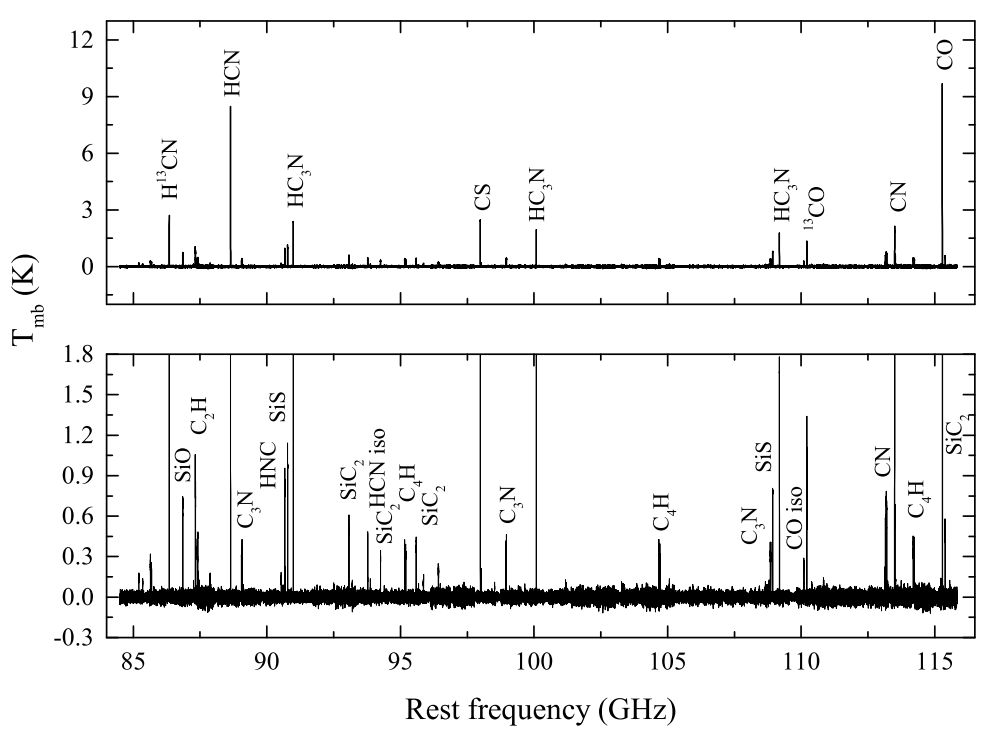IRC+10216 (CW Leo) is the closest and the brightest carbon-rich (C /O > 1) asymptotic giant branch (AGB) star. Astronomers have detected 106 different species (not including isotopologues) in its circumstellar envelope (CSE), making this AGB star a veritable "molecular factory" in interstellar space. Many observations of molecules in the CSE of IRC+10216 using various radio telescopes have been published, but a full-band spectral line survey in the λ 3 mm band was still missing.
Recently, TUO Juan, a Ph.D. candidate under the guidance of Prof. LI Xiaohu from the AstroChemistry Group of the Xinjiang Astronomical Observatory (XAO) of the Chinese Academy of Sciences, together with their collaborators, presented the first unbiased λ 3 mm line survey (between 84.5 and 115.8 GHz) toward the CSE of the carbon-rich AGB star IRC +10216 (Figure 1) using the 13.7 m radio telescope of Purple Mountain Observatory (PMO), Chinese Academy of Sciences. A total of 75 spectral lines (96 transitions) were detected, and identified to arise from 19 molecules and their isotopologues. Among them, one molecular emission line (H13CCCN J = 13-12) was discovered in IRC+10216 for the first time. By assuming that they are in local thermodynamic equilibrium, the excitation temperature, column density, and fractional abundance of the detected species relative to H2 were deduced, and the isotopic ratios of [12C]/[13C], [32S]/[34S], [28Si]/[29Si], and [12C34S]/[13C32S] were obtained. The researchers found that the higher J transitions of HC3N, HC5N, HC7N, HC9N, C3S, CH3CN, SiS, and C4H (ν = 0 and ν = 1) trace the warmer gas relatively close to the star in the CSE of IRC+10216.
The researchers also compared observations of the same transitions of various molecules obtained by radio telescopes with different angular resolutions. It was found that the integral intensity ( TRdv, taking into account the main beam efficiency of the telescope and the beam filling factor) and spectral line profile of strong molecular spectral lines (S/N ≥ 5) are approximately identical when observed by telescopes with different angular resolutions. For the optically thin species that exhibit double-peaked line shapes, a more pronounced intensity contrast can be found between the line wings and the line center when using a telescope with higher spatial resolution.
TRdv, taking into account the main beam efficiency of the telescope and the beam filling factor) and spectral line profile of strong molecular spectral lines (S/N ≥ 5) are approximately identical when observed by telescopes with different angular resolutions. For the optically thin species that exhibit double-peaked line shapes, a more pronounced intensity contrast can be found between the line wings and the line center when using a telescope with higher spatial resolution.
This work also summarized the column densities of all species detected in the CSE of IRC+10216 to date, as well as the results of the latest astrochemical models. The research results fill the gap in spectral line surveys of IRC+10216 in the λ 3 mm band, and this article has been published in the Astrophysical Journal Supplement Series. (Tuo et al. 2024, ApJS).

Figure 1. The spectral line survey towards IRC +10216 in the 3 mm band by the PMO 13.7 m radio telescope.
Contact: TUO Juan
Xinjiang Astronomical Observatory, Chinese Academy of Sciences
Email: tuojuan@xao.ac.cn
Article link: https://iopscience.iop.org/article/10.3847/1538-4365/ad2460